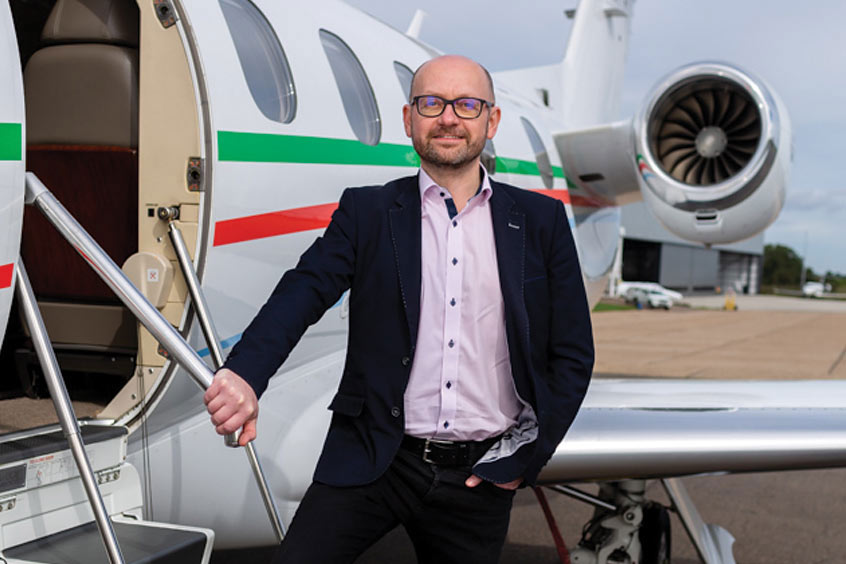
As part of a monthly update from the Sustainability & Innovation Group at The Air Charter Association, chairman and MaceAero CEO Chris Mace shares the group's learnings on sustainability within the air charter industry.
The S&I Group includes members of the main association board alongside members of its NextGen group, a younger set who are likely to witness more catastrophic climate impact if the world’s governments, industries and us as individuals do not pull together and tackle the issue globally and effectively.
Climate change is enormous and so the group's efforts are targeted industry wide, not just within the membership. It is committed firstly to building knowledge and understanding of our environment and our industry's impact on it; to establishing what is already being done by our industry to tackle it, the targets that are being worked towards; and to understanding how we can make changes.
“I can safely say that everyone in the S&I Group has been pleasantly surprised by the level of innovation and momentum the industry has either achieved or has in the pipeline in reducing emissions,” says Mace. “However, at the same time, we are all deeply concerned by the scale of the task ahead and whether it is indeed achievable.”
In order to understand how companies within the air charter industry are tackling the emissions issue, the group is sending out a consultation paper to help benchmark a position whereby it can measure progress in future years. This is available to complete through The ACA’s social media and website.
Aviation emits more than just CO2; two thirds of overall emissions come from sulphur, NOx and contrails. But he feels it is perhaps important to acknowledge that aircraft carrying often just one or two passengers across the world produce a huge level of emissions output per traveller.
Technology and efficiency have already made a positive impact in the industry: in the UK alone, passenger numbers grew by 27 per cent between 2010 and 2016, while total emissions only grew by around 0.2 per cent. This is as a result of investment in new aircraft technology, improved air traffic management and airports investing in reduced energy use on airfields. Huge focus is placed on SAF, emission offsetting schemes as well as electric and hydrogen propulsion, in addition to work on aircraft design and increased efficiency in newer aircraft.
Using SAF results in a reduction in carbon emissions compared to traditional jet fuel. This reduction may be between 80-85 per cent, depending on the sustainable feedstock used, production method and the supply chain to the airport, but the calculations are based on 100 per cent SAF usage, while authorities currently restrict SAF usage to a blend of up to 50 per cent. This blending obviously reduces the overall reduction in CO2 emissions. SAF is costly, around three times the cost of jet fuel right now, so it is crucial to scale up production globally, and improve availability, which in turn will lower costs and make it more affordable.
Carbon offsetting should not be considered as a stand-alone action; offsetting emissions is a continuous process starting with measuring your carbon footprint, setting a strategy to decarbonise your organisation and offsetting residual emissions while you transition to a low-emission operating model. There are many schemes, and big differences between them. Some purely measure CO2 whereas others cover carbon dioxide equivalents - CO2e - a standard unit for measuring carbon footprints where the impact of each different greenhouse gas is converted into an amount of CO2 with an equivalent warming effect. This enables a carbon footprint comprised of lots of different emissions to be expressed as a single number. You need to multiply CO2 emissions by a factor of around 2.5 to approximately calculate the CO2e value.
New zero-emissions technologies embrace innovations in engine and aircraft design to significantly increase efficiency and reduce fuel burn; efficiencies in air traffic management to reduce flight times and thus fuel used; as well as hybrid, electric and hydrogen power. All these developments require significant resource and time to bring to reality, and then need to be trialled and tested to very high levels to comply with aviation regulatory requirements. The pace of this development has been increasing in recent years and we can expect some trial and testing phases before 2025. It is inevitable, due to the initial size and range limitations of the new technology, that business aviation and the charter sector will be the first adopters, and heavily involved in further development.
“So,” says Mace, "we shouldn’t hide from the need to make improvements. Our industry should and is already starting to embrace the changes required. Aviation itself is not the issue, the emissions produced are. Combat the emissions and aviation can, and should, hold its head high and do what we do best; connect people, business and the world.”